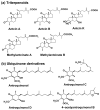Review of Bioactivity, Isolation, and Identification of Active Compounds from Antrodia cinnamomea
- PMID: 36290462
- PMCID: PMC9598228
- DOI: 10.3390/bioengineering9100494
Review of Bioactivity, Isolation, and Identification of Active Compounds from Antrodia cinnamomea
Abstract
Antrodia cinnamomea is a precious and popular edible and medicinal mushroom. It has attracted increasing attention due to its various and excellent bioactivities, such as hepatoprotection, hypoglycemic, antioxidant, antitumor, anticancer, anti-inflammatory, immunomodulation, and gut microbiota regulation properties. To elucidate its bioactivities and develop novel functional foods or medicines, numerous studies have focused on the isolation and identification of the bioactive compounds of A. cinnamomea. In this review, the recent advances in bioactivity, isolation, purification, and identification methods of active compounds from A. cinnamomea were summarized. The present work is beneficial to the further isolation and discovery of new active compounds from A. cinnamomea.
Keywords: Antrodia cinnamomea; bioactive; compound; isolation; purification.
Conflict of interest statement
The authors declare no conflict of interest.
Figures


Similar articles
-
Current Advances on the Structure, Bioactivity, Synthesis, and Metabolic Regulation of Novel Ubiquinone Derivatives in the Edible and Medicinal Mushroom Antrodia cinnamomea.J Agric Food Chem. 2017 Dec 6;65(48):10395-10405. doi: 10.1021/acs.jafc.7b04206. Epub 2017 Nov 21. J Agric Food Chem. 2017. PMID: 29125753 Review.
-
Evidence-Based Nutraceuticals Derived from Antrodia cinnamomea.Foods. 2025 Mar 30;14(7):1212. doi: 10.3390/foods14071212. Foods. 2025. PMID: 40238365 Free PMC article. Review.
-
Antrodia cinnamomea-An updated minireview of its bioactive components and biological activity.J Food Biochem. 2019 Aug;43(8):e12936. doi: 10.1111/jfbc.12936. Epub 2019 Jun 4. J Food Biochem. 2019. PMID: 31368557 Review.
-
Metabolite Profiling and Comparison of Bioactivity in Antrodia cinnamomea and Antrodia salmonea Fruiting Bodies.Planta Med. 2016 Feb;82(3):244-9. doi: 10.1055/s-0035-1558141. Epub 2015 Nov 9. Planta Med. 2016. PMID: 26550789
-
Production of bioactive metabolites by submerged fermentation of the medicinal mushroom Antrodia cinnamomea: recent advances and future development.Crit Rev Biotechnol. 2019 Jun;39(4):541-554. doi: 10.1080/07388551.2019.1577798. Epub 2019 Feb 27. Crit Rev Biotechnol. 2019. PMID: 30810393 Review.
Cited by
-
Molecular Regulatory Mechanism of the Iron-Ion-Promoted Asexual Sporulation of Antrodia cinnamomea in Submerged Fermentation Revealed by Comparative Transcriptomics.J Fungi (Basel). 2023 Feb 10;9(2):235. doi: 10.3390/jof9020235. J Fungi (Basel). 2023. PMID: 36836349 Free PMC article.
-
Biological Functions and Synthesis of the Active Components in Antrodia camphorata.ACS Omega. 2025 Apr 18;10(16):15908-15922. doi: 10.1021/acsomega.5c01669. eCollection 2025 Apr 29. ACS Omega. 2025. PMID: 40321565 Free PMC article. Review.
-
Antcin-H, a natural triterpene derived from Antrodia cinnamomea, ameliorates dextran sulfate sodium-induced colitis in mice by inhibiting the NLRP3 inflammasome.J Tradit Complement Med. 2024 Mar 30;15(4):343-355. doi: 10.1016/j.jtcme.2024.03.016. eCollection 2025 Jul. J Tradit Complement Med. 2024. PMID: 40677541 Free PMC article.
-
Renoprotective Effects of Solid-State Cultivated Antrodia cinnamomea in Juvenile Rats with Chronic Kidney Disease.Nutrients. 2023 Oct 31;15(21):4626. doi: 10.3390/nu15214626. Nutrients. 2023. PMID: 37960279 Free PMC article.
-
Dehydroeburicoic Acid, a Dual Inhibitor against Oxidative Stress in Alcoholic Liver Disease.Pharmaceuticals (Basel). 2022 Dec 22;16(1):14. doi: 10.3390/ph16010014. Pharmaceuticals (Basel). 2022. PMID: 36678511 Free PMC article.
References
-
- Chang T.T., Chou W.N. Antrodia cinnamomea sp. nov. on Cinnamomum kanehirai in Taiwan. Mycol. Res. 1995;99:756–758. doi: 10.1016/S0953-7562(09)80541-8. - DOI
-
- Jin Y., Liu H., Liu J., Xing H., Wang F., Deng L. Efficient production of 4-Acetylantroquinonol B from Antrodia cinnamomea through two-stage carbon source coordination optimization. Bioresour. Technol. Rep. 2021;15:100732. doi: 10.1016/j.biteb.2021.100732. - DOI
Publication types
Grants and funding
LinkOut - more resources
Full Text Sources

